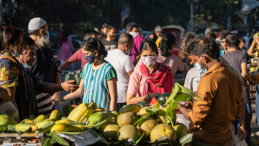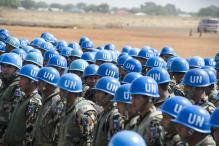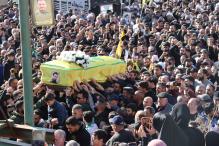As the world marks the International Day for the Elimination of Sexual Violence in Conflict on 19 June, it becomes ever clearer that the COVID-19 pandemic has highlighted and exacerbated the complex root causes of conflict-related sexual violence (CRSV). As a report of the UN Secretary-General recently noted, COVID-19 has given rise to a range of gender-specific protection concerns, with marginalized women and girls in conflict-affected settings facing compounded risks for all manner of adverse outcomes, including sexual violence, exploitation, and trafficking. Now more than ever, there is a need for holistic, survivor-centred approaches to CRSV that are context-specific. New data from the Managing Exits from Armed Conflict initiative demonstrates on the important nuances and intersectionalities that need to be properly understood to enable more effective policymaking and programming to address its underlying causes.
In Resolution 2467 (2019), the Security Council called for a survivor-centred approach to be taken in efforts to address CRSV. This was reflective of work in recent years by Women, Peace and Security stakeholders for a more holistic approach to be taken in addressing this type of violence. In order to successfully prevent and respond to CRSV, its root causes – which often overlap with factors that drive other conflict-related violence – must be systematically addressed and the intersectional identities and dynamics be recognized.
Survivors must be afforded central roles in the planning and implementation of relevant programming and policies. There are efforts already underway to reflect this approach, at both the international and national levels. But more needs to be done to build a comprehensive understanding of the intersectionality of CRSV and other types of violence and victimization.
Managing Exits from Armed Conflict
The Managing Exits from Armed Conflict (MEAC) initiative at the United Nations University Centre for Policy Research (UNU-CPR) takes such an approach. MEAC is a multi-year collaboration to develop a unified, rigorous approach to examining how and why individuals exit armed conflict and evaluating the efficacy of interventions meant to help support their transition to civilian life. This includes data collection processes that aim to capture the specific experiences and needs of girls, boys, women, and men who have been involved in, or are victims of, armed conflict. This approach includes but goes beyond disaggregation of data by gender in order to provide nuanced analyses of the gender dynamics of conflict and their implications for successful reintegration.
MEAC seeks to understand intersectional identities and how they shape the lived experience of conflict, and to translate the information provided by respondents into a format that is easily integrated into the work of policymakers and practitioners – allowing them to hear from not only the conflict-affected individuals whose voices can be heard in public spaces, but from thousands of respondents who together provide a broad view of how violent dynamics are playing out in real time.
Current MEAC case studies include Nigeria and Colombia, where there is a recognized need for data on conflict dynamics – a need to which MEAC has taken efforts to respond, adapting its methodologies to the realities of the COVID-19 pandemic context. On CRSV in particular, MEAC aims to address the need for better evidence while being conscious of context-specific realities, risks of re-traumatizing survivors, challenges in accurately collecting data on a sensitive subject, lack of agreement over what constitutes sexual violence, and survivors’ desire to strengthen policies and programmes that aim to benefit them.
Colombia
Colombia offers an interesting case study to examine the interplay between CRSV and other types of conflict-related violence given the variation across time, geography, and the armed actors involved. In April-May 2021, MEAC carried out a phone survey with 2,460 community members in eleven municipalities in Colombia: three cities and eight conflict-affected rural communities. The survey aimed to gain an understanding of community members’ current and past experiences of conflict-related violence and perceptions of security.
The results varied widely between urban and rural municipalities – unsurprising given their different experiences of the conflict. Diverse types of violence were also reported at different levels even among conflict-affected rural contexts. Across the board, nine per cent of respondents (eight per cent of men and ten per cent of women) reported knowing someone who had experienced CRSV – and this is likely to be below actual levels, given stigma and other obstacles that lead to under-reporting. However, a shared understanding of CRSV can still be enhanced when it is examined alongside the data on other types of violence at the municipal level.
In Apartadó, Antioquia, the percentages of respondents who reported knowing someone who had experienced CRSV and who reported having experienced or knowing someone who had experienced kidnapping was the same: 16 per cent. This was the highest municipal rate of CRSV and the lowest of kidnapping across all 11 municipalities in which the survey was conducted. Furthermore, the percentage of those who knew someone who had been killed was among the highest among all municipalities, at 65 per cent. This relationship between reported CRSV and murder was similar in Mutatá, Antioquia (12 per cent and 71 per cent respectively), and San José del Guaviare, Guaviare (14 per cent and 61 per cent respectively), but did not hold for other conflict-affected communities such as Uribe, Meta (where 5 per cent reported CRSV – the lowest reported – and 69 per cent reported killings). Respondents in these four municipalities were also among those who most frequently reported knowing someone who had disappeared, ranging from 41 per cent in Apartadó to 52 per cent in San José del Guaviare.
There are many reasons why these variations occur across municipalities – from differences in awareness and stigma that could affect reporting, to differences in the tactics used by armed groups over time. However, it is clear from these differences that the response to CRSV must also be different in each place, mindful of local attitudes and customs, and experiences of violence overall.
Nigeria
Similar to Colombia, it can be difficult to measure CRSV in Nigeria because there are significant cultural taboos to openly discussing sexual violence and disagreements over what constitutes it. Rape in the context of a marriage – even a forced union with a fighter from an armed group – is not always understood as sexual violence. Even with those caveats in mind, the prevalence of CRSV is shown to be significant in Nigeria.
Of 3,471 people surveyed in December 2020 - February 2021 in and around Maiduguri – the capital of Borno State in the North East of the country – ten per cent personally knew someone in their community who suffered CRSV at the hands of a party to the conflict. Boko Haram was most often identified as the perpetrator (70 per cent of cases identified by female respondents, compared to 39 per cent by male respondents). The military and the Civilian Joint Task Force (CJTF) – a volunteer security outfit that works with the military – were also identified as perpetrators. Interestingly female respondents were more likely to identify the military as responsible (23 per cent to 13 per cent of male respondents) and male respondents were more likely to identify the CJTF (11 per cent compared to 3 per cent of women). The latter finding may reflect the greater attention men and boys receive from the CJTF, which the same survey showed were more likely to be victims of CJTF harassment or violence.
Community leaders – who can enjoy greater visibility of criminal and conflict-related violence across their communities – report even higher rates of CRSV in and around Maiduguri. When asked as part of a separate survey if they had heard of incidents of sexual violence and misconduct in the last month, 18 per cent of 261 community leaders (e.g., Bulamas, Ward Chairmen) said they had. Interestingly, when asked about sexual violence and misconduct as part of a larger list of criminal acts, community leaders were less likely to report knowing of such incidents (2 per cent). This highlights how important it is to ask specific questions about sexual violence – and to specifically define what it means to ensure consistent comprehension by respondents. In both cases, female community leaders were more likely to report knowing of sexual violence and misconduct – regardless of how the question was asked. There were so few women in the sample it is difficult to generalize, but the gender differential may suggest that sexual violence is more likely to be discussed with certain types of leaders than others. When asked who was behind most of the sexual violence, 13 per cent of community leaders identified Boko Haram. In higher numbers, they also identified State or quasi-State forces – the CJTF (28 per cent of respondents, Yan Gora (non-CJTF) (26 per cent), police (19 per cent), and military (9 per cent). Like with CRSV, the perpetration of other types of crimes – physical violence, shootings – identified by community leaders and community members in the North East of Nigeria in these two surveys are often blamed on a wide array of actors – including State or quasi-State forces – suggesting that this is not isolated to Boko Haram and other non-state groups.
Moving forward
The data collected in Nigeria and Colombia may point to more questions than answers, as we seek to explain these relationships between CRSV and other types of violence. In order to respond to CRSV in a holistic way that takes into account the possibility that survivors have also experienced other forms of violence, either directly or indirectly, it will be essential to enhance the international community’s understanding of the relationships between different types of conflict violence and how to craft effective and efficient CRSV prevention efforts and responses. This requires not only thoughtful data collection, but the full analytical exploitation of that data to examine the underlying dynamics that drive different forms of inter-connected conflict-related violence.
This type of research should not only employ quantitative methods which can provide a “big picture” of the intersectionality of CRSV as has been seen here; it should also use qualitative methods including participatory work that places survivors at its core and provides the means for them to participate in the formulation of policy recommendations that speak directly to their needs and experiences. By adopting these participatory methodologies – more important now than ever as COVID-19 conditions have exacerbated patterns of exclusion of survivors from relevant interventions – research will more effectively contribute to the survivor-centred policy and programming approach that survivors need and deserve.
Suggested citation: Cristal Downing, Van Broeckhoven Kato and O’Neil Siobhan., "New Data Underscores Urgent Need for Holistic Approaches to Conflict-Related Sexual Violence," UNU-CPR (blog), 2021-06-18, https://unu.edu/cpr/blog-post/new-data-underscores-urgent-need-holistic-approaches-conflict-related-sexual-violence.





